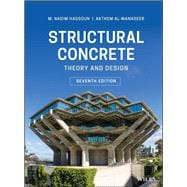The leading structural concrete design reference for over two decades—updated to reflect the latest ACI 318-19 code
A go-to resource for structural engineering students and professionals for over twenty years, this newly updated text on concrete structural design and analysis reflects the most recent ACI 318-19 code. It emphasizes student comprehension by presenting design methods alongside relevant codes and standards. It also offers numerous examples (presented using SI units and US-SI conversion factors) and practice problems to guide students through the analysis and design of each type of structural member.
New to Structural Concrete: Theory and Design, Seventh Edition are code provisions for transverse reinforcement and shear in wide beams, hanger reinforcement, and bi-directional interaction of one-way shear. This edition also includes the latest information on two-way shear strength, ordinary walls, seismic loads, reinforcement detailing and analysis, and materials requirements. This book covers the historical background of structural concrete; advantages and disadvantages; codes and practice; and design philosophy and concepts. It then launches into a discussion of the properties of reinforced concrete, and continues with chapters on flexural analysis and design; deflection and control of cracking; development length of reinforcing bars; designing with the strut-and-tie method; one-way slabs; axially loaded columns; and more.
- Updated to align with the new ACI 318-19 code with new code provisions to include: transverse reinforcement and shear in wide beams, hanger reinforcement, bi-directional interaction of one-way shear, and reference to ACI certifications
- Includes dozens of worked examples that explain the analysis and design of structural members
- Offers updated information on two-way shear strength, seismic loads, materials requirements, and more
- Improves the design ability of students by explaining code requirements and restrictions
- Provides examples in SI units in every chapter as well as conversion factors from customary units to SI
- Offers instructors access to a solutions manual via the book's companion website
Structural Concrete: Theory and Design, Seventh Edition is an excellent text for undergraduate and graduate students in civil and structural engineering programs. It will also benefit concrete designers, structural engineers, and civil engineers focused on structures.








